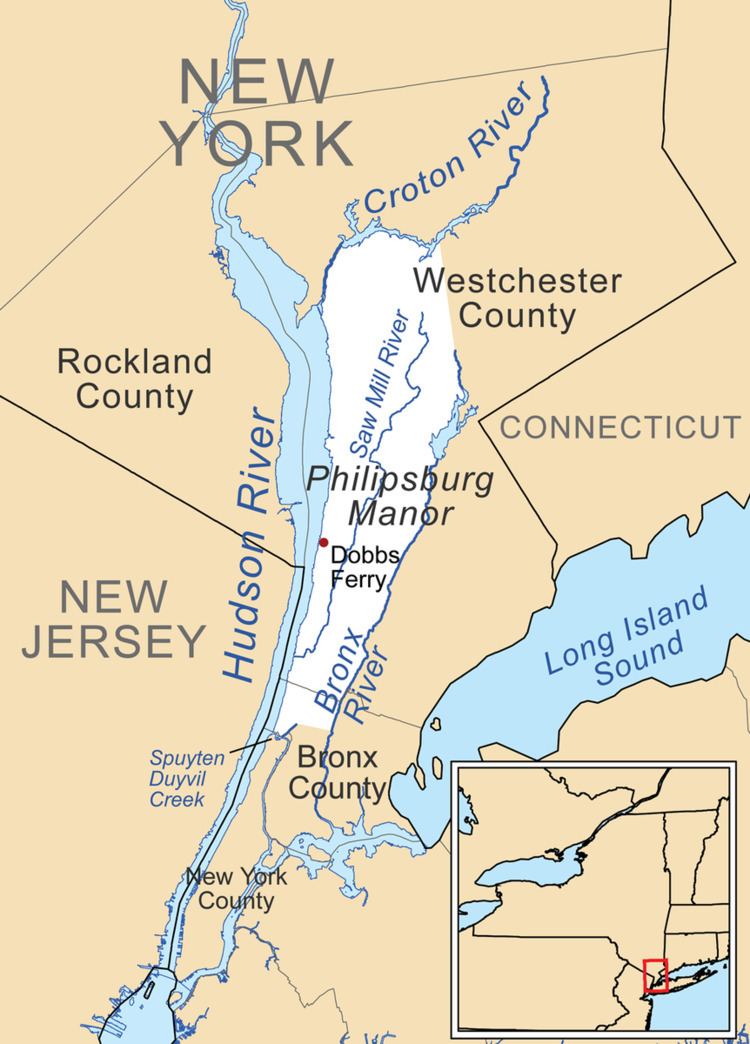Opened 1693 Phone +1 914-366-6900 | Area 8 ha Architect Frederick Philipse | |
 | ||
Similar Old Dutch Church of Sleepy H, Kykuit, Sunnyside, Van Cortlandt Manor, Sleepy Hollow Cemetery | ||
Ms 534 tour of philipsburg manor work
Philipsburg Manor (sometimes referred to as Philipse Manor) was an English manor located north of New York City in the Province of New York. It lasted from 1693 until 1779. The land was part of a Dutch patroonship owned by Adriaen van der Donck but was later purchased by Frederick Philipse I. Philipse was granted a royal charter in 1693, creating the manor as a legal entity. After Philipse's death, the manor was split between his son and grandson, both of whom continued to develop the manor. The Philipses engaged in the Atlantic slave trade, using Africans to construct most of the buildings on the property. The tenant farmers on the manor also represented a diverse population of Europeans.
Contents
The manor's property was eventually sold at auction after Loyalist Frederick Philipse III was attainted for treason by New York's revolutionary government and his land was confiscated. Some of the original structures still stand, including the Philipsburg Manor House in Sleepy Hollow, Philipse Manor Hall (the family seat) in Yonkers, and the Old Dutch Church of Sleepy Hollow, all of which are National Historic Landmarks.
Philipsburg manor
History
The land that would become Philipsburg Manor was first bought from Adriaen van der Donck, who had invested in an unsuccessful Dutch patroonship in New Netherland before the English takeover in 1664. Frederick Philipse I, Thomas Delavall, and Thomas Lewis purchased the first tracts of land in 1672 in current-day northern Yonkers. Philipse made several additional purchases between 1680 and 1686 from the Wiechquaeskeck and Sinsink Indian tribes, expanding the property both north and south of the previous purchase; he also bought a small plot of land from the Tappans west of the Hudson River. The manor comprised about 52,000 acres (21,000 ha) of land. Philipse also bought out his partners' stakes during this time.
The estate's boundaries were the Spuyten Duyvil Creek to the south, the Croton River to the north, the Hudson River to the west, and the Bronx River to the east. Philipse was granted a royal charter in 1693, creating the Manor of Philipsburg and making him first lord of the manor. Along with the three other main manors of the colony—Rensselaerswyck, Cortlandt, and Livingston—Philipsburg created one of the richest and most powerful families in the colony. When Philipse died in 1702, the manor was divided between his son, Adolphus Philipse, and his grandson, Frederick Philipse II. Adolph received the Upper Mills property, which extended from Dobbs Ferry to the Croton River. Frederick II was given the Lower Mills at the confluence of the Saw Mill and Hudson Rivers; the two parcels were reunited on his uncle's death. Frederick II's son, Frederick III, became the third lord of the manor in 1751.
The Philipses used African slaves to build various structures at the Upper Mills and Lower Mills. The Upper Mills saw the building of two gristmills on the Pocantico River as well as a stone manor house, wharf, cooperage, and bake house. Most of the structures were completed by 1697, including the Old Dutch Church of Sleepy Hollow, now a National Historic Landmark. The Lower Mills saw a gristmill and manor house built on the north bank of the Neperhan River. The Philipses' aim was to make the manor a center for agriculture, which the achieved.
The slaves came from 22 African cultures from Kongo-Angola. In the 18th century, tenant farmers moved in from Great Britain, the Netherlands, France, Germany, and even elsewhere within North America. By the beginning of the American Revolution in 1776, the population was about 1,000, up from 200 at the time of Frederick I's death.
In 1779, Frederick Philipse III, a Loyalist, was attainted for treason along with his family. The manor was confiscated and sold at public auction, and the land was split between 287 buyers. The largest tract of land (about 750 acres (300 ha)), the Upper Mills, was passed to numerous owners until 1951, when it was acquired by Sleepy Hollow Restorations (now Historic Hudson Valley). Thanks to the philanthropy of John D. Rockefeller Jr., about 20 acres (8.1 ha) were restored as an historic site known as Philipsburg Manor. The Lower Mills manor house, Philipse Manor Hall, served as Yonkers City Hall from 1872 until 1908. Both houses became National Historic Landmarks on November 5, 1961 and are now house museums.
